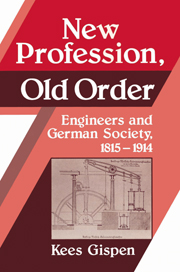Book contents
- Frontmatter
- Contents
- List of tables
- List of figures
- Preface
- Abbreviations
- Introduction
- Part I Emulation: Bildung and the bureaucratic order
- Part II Reorientation: industrial capitalism and a “practical” profession
- 5 Reorientation in the engineering industry, 1876–1884
- 6 Crisis and renewal in the VDI, 1877–1890
- 7 The rebirth of nonacademic engineering education, 1879–1901
- 8 Public authority, private power, and the production of engineering personnel, 1901–1914
- Part III The crucible: technical careers and managerial power, 1900–1914
- Epilogue
- Appendix
- Bibliographical note
- Index
7 - The rebirth of nonacademic engineering education, 1879–1901
Published online by Cambridge University Press: 11 September 2009
- Frontmatter
- Contents
- List of tables
- List of figures
- Preface
- Abbreviations
- Introduction
- Part I Emulation: Bildung and the bureaucratic order
- Part II Reorientation: industrial capitalism and a “practical” profession
- 5 Reorientation in the engineering industry, 1876–1884
- 6 Crisis and renewal in the VDI, 1877–1890
- 7 The rebirth of nonacademic engineering education, 1879–1901
- 8 Public authority, private power, and the production of engineering personnel, 1901–1914
- Part III The crucible: technical careers and managerial power, 1900–1914
- Epilogue
- Appendix
- Bibliographical note
- Index
Summary
In spite of the turn to applied science and practical engineering, the organization of the technische Hochschulen after 1879 all but made inevitable the reestablishment of simpler schools for the masses of rank-and-file engineers. Industry could not possibly fill its rapidly growing number of positions with engineers who had the Abitur and a four-year higher technical education. Contemporaries recognized this fact – and the consequent inevitability of two distinct categories of engineers. At the time, no one thought this would cause problems. Quite the contrary, Grashof and others reckoned that it could only improve the social position and careers of academically trained engineers. All the less desirable and routine functions would go to nonacademic engineers, permitting the engineers from the technische Hochschule to concentrate on the more prestigious tasks.
In fact, the opposite happened. The nonacademic engineering schools, established in part to remedy the ravages of the Industrial Revolution among the lower classes and to stabilize the social order at the point where it seemed to need shoring up most, eventually gave rise to indiscriminate intermingling of the two categories of engineers. The consequence was fierce competition, internecine warfare, resentment of all those who could remotely be blamed for this state of affairs, and a major career crisis in the engineering profession. In other words, the nonacademic engineering schools may have contributed to industrial success and to the integration of the working class into German society, thereby reducing the threat of revolution from the left.
- Type
- Chapter
- Information
- New Profession, Old OrderEngineers and German Society, 1815–1914, pp. 160 - 186Publisher: Cambridge University PressPrint publication year: 1990



